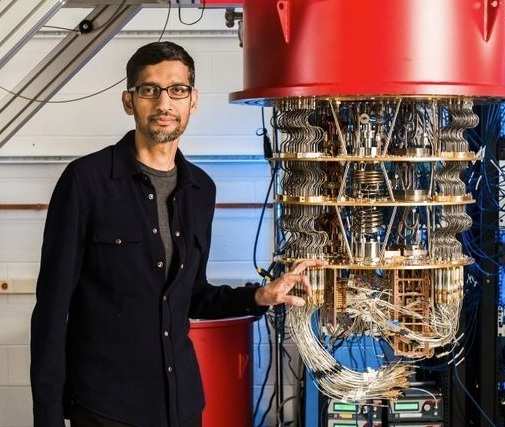Google Quantum Computer Successfully Creates a Time Crystal. What is Time-Crystal?
The revolutionary new material has a repeating pattern in time the way ordinary crystals have a repeating pattern in space; and it points the way to radical new technologies.Artificial Intelligence,Science,Category: Computing,Category: News,Google,Quantum computing,Google Sycamore,type_news,channel_computing,TRBC,van_buying_guide_progressive,serversidehawk,[“Block 3″,”entropy”,”Google”,”Quantum computing”,”Second law of thermodynamics”,”Sir Isaac Newton”,”Time crystal”],”articleSection”:[“Science”],”inLanguage”:”en-US”. You may be wondering what the crystal of time is. Described as a new phase of matter out of equilibrium, it is a crystal that remains stable and ordered. Google scientists noticed Artifact with a Future Name: A Time Crystal. They did it with equally advanced equipment: a Quantum computer. What are time? Google says it may have produced a ‘Time Crystal’, a quantum system that violates one of the most fundamental laws of physics

Scientists with Google’s quantum processing division just distributed an examination to the pre-print worker ArXiv professing to have made physical science resisting “Time Crystals” utilizing the organization’s Sycamore quantum computer, and it’s really difficult to say how huge of an arrangement this may end up being.
As Quanta Magazine clarifies, a time crystal is both stable and continually in motion, with perceptible states rehashing at unsurprising spans while never dissolving into a condition of complete haphazardness.
Without getting too hindered in up-turns and down-twists of the qubits (the sub-nuclear particles that can address both 1 and 0 and which are the establishment of quantum processing), what Google professes to have done is basically taken a checkers board with every one of the red pieces on one side and every one of the dark pieces on the other and figuratively struck the table so as to consummately switch the different sides without using any energy.
The second law of thermodynamics says that this basically can’t occur, yet time crystals don’t appear to care at all about entropy and presently Google is saying that it’s seen one in real life, however that the cycle which delivered it is adaptable – and the ramifications of that could be tremendous.

As indicated by a report at ZDNet.com, in another exploration paper, Google researchers guarantee to have utilized a quantum processor for a helpful logical application: to notice a veritable time crystal.
On the off chance that “time crystal” sounds pretty science fiction that is on the grounds that they are.
Time crystals are no not exactly another “period of issue,” as specialists put it, which has been estimated for certain years now as another express that might actually join the positions of solids, fluids, gases, crystals, etc.
As you can envision, time crystals are slippery … they are not remaining on a traffic intersection, holding back to be found.
In any case, Google’s researchers presently guarantee that their outcomes build up a “adaptable methodology” to consider time crystals on ebb and flow quantum processors, ZDNet.com revealed.
Understanding why time crystals are intriguing requires a tad of foundation in physical science – especially, information on the second law of thermodynamics, which expresses that frameworks normally will in general get comfortable a state known as “most extreme entropy.”
Time crystals, researchers say, neglect to get comfortable warm balance.
Rather than gradually deteriorating towards haphazardness, they stall out in two high-energy designs that they switch among — and this to and fro interaction can go on for eternity.
To clarify this better, ZDNet.com conversed with Curt von Keyserlingk, speaker at the school of physical science and cosmology at the University of Birmingham, who didn’t partake in Google’s most recent trial.
It begins with a psychological study: take a container in a shut framework that is segregated from the remainder of the universe, load it two or three many coins and shake it 1,000,000 times.
As the coins flip, tumble and skip off one another, they haphazardly move positions and progressively become more turbulent, says von Keyserlingk.
After opening the container, the assumption is that you will be confronted with generally a large portion of the coins on their heads side, and half on their tails.
It doesn’t make any difference if the trial began with more coins on their tails or more coins on their heads: the framework fails to remember what the underlying design was, and it turns out to be progressively arbitrary and tumultuous as it is shaken.
Enter Google’s quantum processor, Sycamore, which is notable for its accomplishments and is currently searching for some sort of valuable application for quantum figuring, ZDNet.com announced.
A quantum processor, by definition, is an ideal instrument to duplicate a quantum mechanical framework, says von Keyserlingk.
In this situation, Google’s group addressed the coins in the crate with qubits (units of quantum data) turning upwards and downwards in a shut framework; and rather than shaking the case, they applied a bunch of explicit quantum activities that can change the condition of the qubits, which they rehashed ordinarily.
This is the place where time crystals overcome all presumption.
Taking a gander at the framework after a specific number of activities, or shakes, uncovers a design of qubits that isn’t arbitrary, however rather looks somewhat like the first set up.
“The principal fixing that makes up a time crystal is that it recalls what it was doing at first. It doesn’t neglect,” says von Keyserlingk. “The coins-in-a-container framework neglects, yet a time crystal framework doesn’t.”
The abnormality doesn’t stop here.
Shake the framework a much number of times, and you’ll get a comparable design to the first one – however shake it an odd number of times, and you’ll get another set up, in which tails have been turned to heads and the other way around.
Researchers call this a break in the balance of time – which is the reason time crystals are called along these lines, ZDNet.com announced.
In contrast to the coins in the crate, which get all obfuscated up and settle at generally half heads and half tails, they buck the entropy law by stalling out in an exceptional, time-crystal state.
Newton’s second law of thermodynamics says that this can’t occur, however time crystals don’t appear to care at all about entropy.
Contemplate that one briefly.
Time crystals have been a subject of interest since 2012, when Nobel Prize-winning MIT teacher Frank Wilczek began pondering them; and the hypothesis has been discredited, discussed and negated ordinarily.
Just last month, a group from Delft University of Technology in the Netherlands distributed a pre-print showing that they had assembled a time crystal in a jewel processor, albeit a more modest framework than the one asserted by Google.
There are, obviously, a few provisos.
Like all quantum computers, Google’s processor actually experiences decoherence, which can cause a rot in the qubits’ quantum states.
What’s more, one thing is sure: time crystals will not be sitting in our family rooms any time soon, as researchers still can’t seem to track down a conclusive helpful application for them.
All things considered, on the off chance that what Google’s quantum computer achieved can be duplicated, time crystals aren’t simply genuine, yet they may really be put to some real true use.
The ramifications of such an innovation for computer memory alone are difficult to understand, substantially less for computer preparing itself.
This is a New “Network of Object”, Has been guessed for certain years by certain analysts. It isn’t about solids, fluids, gases, crystals, and so on
We need to return a stage to additionally explain this angle The second law of thermodynamics, Systems normally move towards warm harmony, for example a Less viable and more potty.
For instance, in the event that we empty espresso into some milk, it will initially be on top of the fluid in the compartment. Be that as it may, over the long run, it will break down all through the milk, coming to “computer harmony” and disseminating itself Normally Paul inside.
According to this point of view, Time crystals are a special case, Because They can’t situate themselves in warm balance. As such They don’t disintegrate haphazardly however go to and fro between two setups In a cycle that can go on endlessly.
By Google’s Quantum Processor, Scientists had the option to mirror a “quantum mechanical framework” equivalent to a specific measure of coins in a crate. As per the second law of thermodynamics, moving the crate the coins should be orchestrated arbitrarily: the assumption is that the head ought to be half upwards and a large portion of the view at the cross.
Be that as it may, on account of Google’s processor, analysts kept on utilizing it Specific quantum capacities, Can Change the situation of the stops (I.e., in our model, coins). It is now that the “time crystals” surpass all assumptions: the computer, after a specific number of activities, or shocks, Reveals a quid structure that isn’t irregular, But it is very similarThe unique framework.
For data, a time crystal comprises of three essential components: a line of particles each with a particular attractive direction encompassed by a combination of low and high energy arrangements, which are called ” Multi-office limitation The subsequent segment is the inversion of the headings of these particles which is classified “request of appropriate state”. This is an optional restricted condition of many bodies. At long last, the laser light which causes a pattern of states without utilizing the net energy of the actual laser. The outcome is known as ” Temporary crystal accident The analysts presumed that this exploration gives A transformative way to deal with examining the awkwardness phases of issue on current quantum processors ».
Ceaseless movement is against the laws of material science, as we right now get them, yet the crystals orchestrated utilizing Google’s super amazing Sycamore quantum computer don’t appear to be excessively annoyed by the laws of physical science.
Nobel prize-winning physicist Frank Wilczek previously guessed the presence of time crystals in 2012, however their standard breaking properties acquired him a ton of analysis in the science foundation: “I took a great deal of misery,” he says.
A few exploration bunches have been on the path of the slippery equation for Time Crystals for quite a long while.
Microsoft’s Station Q bunch have approached, and Norman Yao at the University of California, Berkeley, distributed an outline for making the rehashing crystals in 2017.
Yet, the fundamental declaration from Google, which is yet to go through full friend survey, asserts that the organization’s group has made a time crystal, yet that the cycle which created it is versatile – implying that can make as numerous as they prefer.
It’s anything but a distortion to say that – expecting that the Google declaration rises up to peer-survey – this is an all out distinct advantage for computers.
A functioning quantum computer that can switch the conditions of its segments without utilizing any energy could make the way for valid, mindful, man-made reasoning and countless innovative improvements past that.
